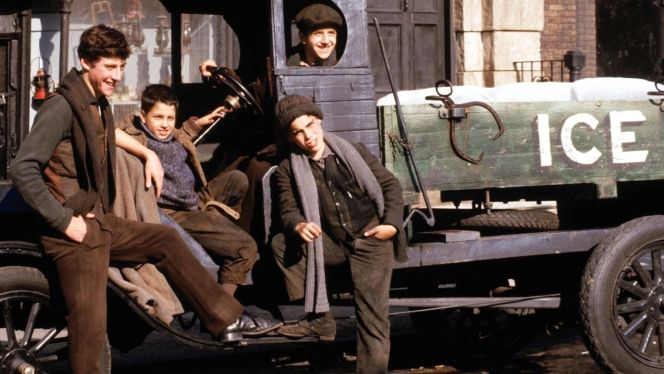RETRO FILM REVIEW – Sergio Leone’s legendary crime epic, “Once Upon a Time in America,” depicts the brutalities of 1930s America with breathtaking elegance and realism, particularly focusing on the ruthless and bloody sagas of immigrant-formed gangster crews. This year marks the fortieth anniversary of this masterpiece, a fitting moment to revisit this film especially since it will soon disappear from Netflix, offering us one last chance to experience the dark tales of early twentieth-century New York on this platform.
From the inception of the film industry, American directors have endeavored to capture the true essence of their homeland on screen. Classics like “On the Waterfront” and “The Last Picture Show” are renowned for their honest and nuanced portrayal of a proud yet profoundly fractured nation. However, sometimes it takes an outsider to reveal the true face of a place, and in this regard, Sergio Leone’s work in “Once Upon a Time in America” uniquely illustrates the glorious yet threatening tragedy of the USA.
Viewed today, the film is not only a true cinematic classic but also a pinnacle of filmmaking; Leone’s final work and his greatest masterpiece, radiates the grand illusion of the American Dream in every aspect. Narratively, it delves into the dense, violently xenophobic era of early American society, starkly portraying the roots of male-dominated corruption that still define many power structures today. Culturally, the film captures a defining moment that expresses both the agony and ecstasy of American dreams, an extraordinary film regrettably butchered at its U.S. release (a more complete version was distributed in Europe) and one of the most egregious studio blunders just before Leone’s heart-wrenching death. Many believe the intense drama surrounding the film’s release and editing – indeed, Leone’s magnum opus – contributed to the Italian director’s relatively early demise.
A Lifetime, A Dream
Originally a near six-hour saga reduced to a 229-minute film, it traces the life arcs of Jewish immigrants turned mob bosses. Under the guidance of Robert De Niro and James Woods, Leone chronicles their rise from street kids in the Jewish ghettos of turn-of-the-century New York to their ascent into a world of opulence, corruption, misogyny, and betrayal, becoming merciless, unyielding men. Presented in a non-linear, mosaic-like fashion, the film unfolds the lives, criminal careers, character development, and regressions of Noodles (Robert De Niro) and Max (James Woods), as they ruthlessly break through a society imbued with systemic oppression and brutality. More intelligently, more deeply impactful, and artistically crafted than its contemporaries in editing, cinematography, and scoring, this film is a true masterpiece within the gangster genre, long tragically overlooked alongside other gangster legends such as “The Godfather” series and “Goodfellas.”
When “Once Upon a Time in America” was shown out of competition at the 1984 Cannes Film Festival, it was met with a 15-20 minute standing ovation so loud that it was reportedly heard in nearby cafés. In stark contrast, its U.S. premiere faced rejection from both critics and audiences alike, with some branding it the worst film of the year. The 229-minute version submitted by Leone was drastically cut down to 139 minutes by American distributors, The Ladd Company, with the help of an assistant editor from “Police Academy,” in stark opposition to the director’s intentions. This action was so controversial and poorly executed that Ennio Morricone’s incredible score, which ranks among the best in both the Master’s and film music history, was disqualified from Academy Award consideration because the producers failed to credit it properly in the new version.
In 2012, American audiences finally had the chance to discover Leone’s grand, nearly four-hour vision when Martin Scorsese successfully restored most of the film for a Cannes screening and DVD/Blu-Ray re-release. As for streaming platforms, the film was previously available in nearly its four-hour version on Amazon Prime and HBO Max, but unfortunately, it is now only available on Netflix and is soon to be removed, so hurry if you want to catch it.
The Blurred Lines of Reality and Fiction
Leone’s epic significantly differs from traditional big American films as it uncompromisingly showcases the country’s real face. Unlike the often glorified mafia films like “Goodfellas” or “The Godfather” – the latter of which Leone turned down to make this film – the gangsters in “Once Upon a Time in America” are portrayed with brutal honesty. While “The Godfather” presents beloved characters such as Clemenza or Marlon Brando and Al Pacino’s charismatic Don Corleones as complex but fundamentally sympathetic and loveable, Leone’s film shows mobsters in their true light: selfish, violent, and emotionally damaged, occasionally behaving in particularly repulsive ways.
This aspect keeps the film surprisingly relevant today, as “Once Upon a Time in America” is not just a crime epic but also paints a complex portrait of young men living under oppressive power structures, aggressively dominant, dismissive of women, and obsessively pursuing sexual dominance.
The prevalent depiction of sexual violence against women in American films is horrifically highlighted in “Once Upon a Time in America” through a brutal scene that starkly illustrates the dangers of such male behavior. While I would never advocate for films that glorify this type of violent narrative, it seems natural that a film steeped in American history and culture would deeply engage with violence against women. Here I am not only referring to the two explicit, major rape scenes in the film (the second of which is particularly heart-wrenching) but also to scenes like the one where Max demonstrates to Noodles how little he regards “whores,” including his own girlfriend (who, to be fair, initially fits that description before she falls in love with Max and starts treating him as her partner).
Irresistible ‘Kosher Nostra’ Mobsters
Somehow, despite their often particularly repulsive and even stomach-turning actions, Leone’s “Kosher Nostra” criminals remain captivating and charismatic, making it impossible to take our eyes off them. Like any truly great mafia epic, Noodles and Max are mirrors of their times: shaped by early 20th-century America into who they are. In typical Leone fashion, the director often communicates with the audience or introduces emotional depth not necessarily through the otherwise perfect plot or fantastically authentic sets, but by focusing on his characters’ faces and gazes, or by showcasing their emotions and thoughts through long, extreme close-ups. These close-ups have become integral to the language of cinema, with Quentin Tarantino also emphasizing the importance of Leone’s technique. But even more significant is Leone and his cinematographer Tonino Delli Colli’s dedication to portraying the real face of America, with all its beauty, decadence, and decay.
The film presents three different eras of American history in a non-linear fashion: the tough Jewish ghettos on Manhattan’s Lower East Side in the 1920s, the Great Gatsby-like exuberance of the 1930s Prohibition era, and the dark, brutal gang-ridden streets of 1968 New York. Leone captures each era in New York with poetic fidelity, through the camera and the soul. De Niro, as Noodles, views the Big City with childlike wonder in his early years, a city many consider a synecdoche for the entire country. The wide shot of Noodles’s gang walking in Lower Manhattan with the massive Manhattan Bridge in the background has become iconic, with the old bridge almost resembling a giant from a fairy tale. Later, when De Niro’s character is released from prison, the Prohibition-era New York is portrayed almost like a playground for men of power, where wealth, gaudy costumes, and grandiosity fill every frame.
And then Leone’s vision of New York in 1968 is foreign and strange, perhaps reflecting what his view of the country might have felt like, being an aging Italian native making films in an industry that had deeply shifted from its auteristic roots, with frisbees whizzing around the city like UFOs and Rockwell-esque bar scenes amidst darkened corridors appearing almost like dreams.
The Deeply Mysterious Ending
The deeply mysterious ending of “Once Upon a Time in America” has puzzled viewers for decades. The film, which begins with an image of De Niro as a young man in 1930s New York silencing the terror of his tormented criminal life by suckling on a long pipe in an opium den, also ends with the same scene—although this time, Noodles is lying with his face up, smiling at the camera. Was it all a dream? Or perhaps a nightmare?
One cannot help but wonder what this ending might have meant to Leone, a filmmaker who was as profoundly influential to American cinema and culture in general as he was indebted to it. His obsession with cowboys in the American west, and the lawlessness of a country that, from its earliest days, was relentless against the weak and uninitiated, may have imbued the director with this mysterious sense of narrative and moral ambiguity.
Leone died shortly after the film was released in its ruinous form by studio producers keen on presenting a more traditional movie for the multiplexes. His colleagues and collaborators have spoken at length in interviews about how the changes to “Once Upon a Time in America” deeply hurt the last great Italian auteur, with James Woods even going so far as to say that Leone died of a broken heart. Today, in light of what the film tried to accomplish, and how it was treated upon release by a changing 1980s culture where the divide between the Raging Bulls and the Rocky IVs was ever-widening, the ending feels exceptionally haunting. Whatever the meaning, it feels only natural that a film about the American dream should end with something resembling a nightmare.
-Herpai Gergely (BadSector)-
Once Upon a Time in America
Direction - 10
Actors - 10
Story - 10
Visuals/Music/Sounds - 10
Ambience - 10
10
MASTERPIECE
Sergio Leone's final great work, "Once Upon a Time in America," represents the pinnacle of the director's artistic vision, offering a detailed portrayal of 1930s American society's darker aspects. The genius of this film, often hailed as one of the best gangster films of all time, lies in its details—from Leone's magical filmmaking techniques to the multi-layered, engaging plot, the microscopic examination of characters' faces, or the perfectly authentic depiction of historical periods. While initially not receiving the recognition it deserved, the film has since achieved iconic status and is widely acknowledged by critics worldwide.

















Leave a Reply